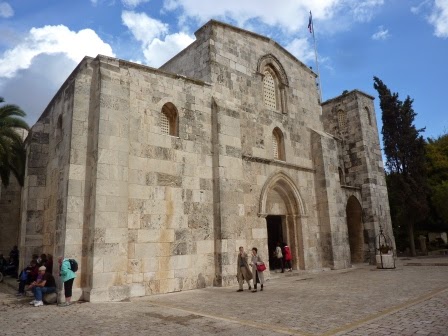The first stop was the Mount of Olives which is just outside of the old walled part of the city. From there we had a fantastic view of the old part of Jerusalem. There were stone walls all around the city.
Next we went to the BYU Jerusalem Center. It was really beautiful there and we got to attend Sacrament meeting ( church service) there since it was Saturday (the Sabbath in Jerusalem). We heard some interesting testimonies from the students attending school there, and one from a student that after she went through the BYU program was going to a Palestinian College and living with a Muslim family.
We drove down to Old Jerusalem and walked along the East Wall of the city.
We entered through the Lion's Gate. During the Arab Israeli War this is where the Israeli troops stormed and city and took back control Jerusalem. They left the bullet holes in the wall as a testimonial to the war.
Our first stop in the city was Antonia's Palace. This is where Jesus was taken and whipped and scourged by Pilate and the Romans.
We got to go down in the dungeons here where they took Jesus and held him overnight and it was really glum.
During a short 30 minute lunch break, Jacquelyn and I walked through part of the Muslim Quarter of the city. It was very interesting. Lots of unusual food.
Our next stop was at some gardens and a church built to memorialize Mary's mother Anna. I learned some interesting history about Jesus' family and why some people think he was taken to England as a boy.
Some interesting ruins to explore.
This is the church built to honor Anna. It was built by the Crusaders.
Close by we saw the Pool of Bethesda, where Jesus healed the paraplegic beggar who couldn't get down into the waters when they were stirred up.
Mary and her mother Anna.
Inside the church which was built by the crusaders for Anna.
Then we went on a walk that had twelve stops where different things happened to Jesus along the path, where he carried the cross to be crucified, called Via Dolorosa, or Way of Suffering. It ended at this large church that was jointly owned by several different religions (Greek Orthodox, Catholic, Jewish, etc..) They built a lot of beautiful shrines there. It was very crowded with other tourists. This is where the Catholics think he was crucified, but we know Golgotha was outside the city, and we were going there the next day.
This is the stone they think his body was laid upon after being taken down to be buried. People think of it as holy and they would lay things on it because they thought those things would became holy relics also.
This is where they think he was buried and there was a shrine built there inside the church.
We didn't go in because the lines were super long and we knew we would be going to the Garden Tomb in two days, which is the more likely place of his burial.
The buses went back to the hotel after that, but Jacquelyn and I took the option to stay and explore a little of Old Jerusalem on our own. We saw the Muslim, Jewish, Armenian, and Christian quarters. We even found the Wailing Wall. The only bad thing was, it started raining real hard, and we had to walk back to the hotel in the dark in the rain and got drenched. It was a full day.








































